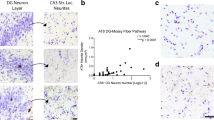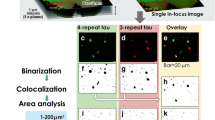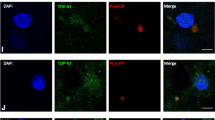Abstract
Regional progression of neurofibrillary tangles (NFTs) around the hippocampus was traced on thick sections double immunofluorolabeled with RD3 and RD4 antibodies, specific for three- and four-repeat tau, respectively. As reported, the cubic density of all tau-positive neurons was predominant in the entorhinal cortex and cornu ammonis (CA)1, and decreased progressively to the CA2–4 subregions. Among the three isoform profiles (RD3+/4−, RD3+/4+, and RD3−/4+), this regional gradient was replicated with RD3+/4− and RD3+/4+ neurons, while RD3−/4+ neurons exhibited the reverse gradient. Comparison of the subregion pairs confirmed a consistent profile shift along this gradient in every case regardless of the abundance of NFTs. To clarify the underlying mechanism of this regional profile shift, intraneuronal intensity of RD3 and RD4 immunoreactivity (IR) was quantified. Although their intensities were both lower in dendrites than in the soma, this gradient was steeper with RD4, leaving RD3 IR in dendrites. Dendritic arborization was abundant in RD3−/4+ pretangles, attenuated in RD3+/4+ neurons, and further attenuated in RD3+/4− ghost tangles. These findings suggest that dendritic RD4 IR retracts first, leaving RD3 IR in the dendrites. Taken together, this dendrite-oriented retraction initiates the gradual shift from RD3−/4+ pretangle neurons to RD3+/4− ghost tangles by way of RD3+/4+ NFTs. This intraneuronal profile shift may be a basis for the regional gradation featured by the similar profile shift during progression of NFT pathology.











Similar content being viewed by others
References
Bancher C, Brunner C, Lassmann H, Budka H, Jellinger K, Wiche G, Seitelberger F, Grundke-Iqbal I, Iqbal K, Wisniewski HM (1989) Accumulation of abnormally phosphorylated tau precedes the formation of neurofibrillary tangles in Alzheimer’s disease. Brain Res 477:90–99
Barghorn S, Mandelkow E (2002) Toward a unified scheme for the aggregation of tau into Alzheimer paired helical filaments. Biochemistry 41:14885–14896
Bezprozvanny I, Mattson MP (2008) Neuronal calcium mishandling and the pathogenesis of Alzheimer’s disease. Trends Neurosci 31:454–463
Boutajangout A, Boom A, Leroy K, Brion JP (2004) Expression of tau mRNA and soluble tau isoforms in affected and non-affected brain areas in Alzheimer’s disease. FEBS Lett 576:183–189
Braak E, Braak H (1997) Alzheimer’s disease: transiently developing dendritic changes in pyramidal cells of sector CA1 of the Ammon’s horn. Acta Neuropathol 93:323–325
Braak E, Braak H, Mandelkow EM (1994) A sequence of cytoskeleton changes related to the formation of neurofibrillary tangles and neuropil threads. Acta Neuropathol 87:554–567
Braak H, Braak E (1991) Neuropathological stageing of Alzheimer-related changes. Acta Neuropathol 82:239–259
Braak H, Del Tredici K (2011) Alzheimer’s pathogenesis: is there neuron-to-neuron propagation? Acta Neuropathol 121:589–595
Campos-Pena V, Tapia-Ramirez J, Sanchez-Torres C, Meraz-Rios MA (2009) Pathological-like assembly of tau induced by a paired helical filament core expressed at the plasma membrane. J Alzheimers Dis 18:919–933
Clavaguera F, Bolmont T, Crowther RA, Abramowski D, Frank S, Probst A, Fraser G, Stalder AK, Beibel M, Staufenbiel M, Jucker M, Goedert M, Tolnay M (2009) Transmission and spreading of tauopathy in transgenic mouse brain. Nat Cell Biol 11:909–913
Connell JW, Rodriguez-Martin T, Gibb GM, Kahn NM, Grierson AJ, Hanger DP, Revesz T, Lantos PL, Anderton BH, Gallo JM (2005) Quantitative analysis of tau isoform transcripts in sporadic tauopathies. Brain Res Mol Brain Res 137:104–109
de Calignon A, Polydoro M, Suarez-Calvet M, William C, Adamowicz DH, Kopeikina KJ, Pitstick R, Sahara N, Ashe KH, Carlson GA, Spires-Jones TL, Hyman BT (2012) Propagation of tau pathology in a model of early Alzheimer’s disease. Neuron 73:685–697
de Silva R, Lashley T, Gibb G, Hanger D, Hope A, Reid A, Bandopadhyay R, Utton M, Strand C, Jowett T, Khan N, Anderton B, Wood N, Holton J, Revesz T, Lees A (2003) Pathological inclusion bodies in tauopathies contain distinct complements of tau with three or four microtubule-binding repeat domains as demonstrated by new specific monoclonal antibodies. Neuropathol Appl Neurobiol 29:288–302
Dubois B, Feldman HH, Jacova C, Dekosky ST, Barberger-Gateau P, Cummings J, Delacourte A, Galasko D, Gauthier S, Jicha G, Meguro K, O’Brien J, Pasquier F, Robert P, Rossor M, Salloway S, Stern Y, Visser PJ, Scheltens P (2007) Research criteria for the diagnosis of Alzheimer’s disease: revising the NINCDS-ADRDA criteria. Lancet Neurol 6:734–746
Duyckaerts C, Colle MA, Dessi F, Grignon Y, Piette F, Hauw JJ (1998) The progression of the lesions in Alzheimer disease: insights from a prospective clinicopathological study. J Neural Transm Suppl 53:119–126
Eidenmuller J, Fath T, Maas T, Pool M, Sonte E, Brandt R (2001) Phosphorylation-mimicking glutamate clusters in the prolin-rich region are sufficient to simulate the functional deficiencies of hyperphosphorylated tau protein. Biochem J 357:759–767
Elbaum-Garfinkle S, Ramlall T, Rhoades E (2010) The role of the lipid bilayer in tau aggregation. Biophys J 98:2722–2730
Frost B, Jacks RL, Diamond MI (2009) Propagation of tau misfolding from the outside to the inside of a cell. J Biol Chem 284:12845–12852
Garden GA, La Spada AR (2012) Intercellular (mis)communication in neurodegenerative disease. Neuron 73:886–901
Glatz DC, Rujescu D, Tang Y, Berendt FJ, Hartmann AM, Faltraco F, Rosenberg C, Hulette C, Jellinger K, Hampel H, Riederer P, Moller HJ, Andreadis A, Henkel K, Stamm S (2006) The alternative splicing of tau exon 10 and its regulatory proteins CLK2 and TRA2-BETA1 changes in sporadic Alzheimer’s disease. J Neurochem 96:635–644
Gouras GK, Tampellini D, Takahashi RH, Capetillo-Zarate E (2010) Intraneuronal beta-amyloid accumulation and synapse pathology in Alzheimer’s disease. Acta Neuropathol 119:523–541
Gray EG, Paula-Barbosa M, Roher A (1987) Alzheimer’s disease: paired helical filaments and cytomembranes. Neuropathol Appl Neurobiol 13:91–110
Hall GF, Chu B, Lee G, Yao J (2000) Human tau filaments induce microtubule and synapse loss in an in vivo model of neurofibrillary degenerative disease. J Cell Sci 113:1373–1387
Hardy J, Revesz T (2012) The spread of neurodegenerative disease. N Engl J Med 366:2126–2128
Harris JA, Devidze N, Verret L, Ho K, Halabisky B, Thwin MT, Kim D, Hamto P, Lo I, Yu GQ, Palop JJ, Masliah E, Mucke L (2010) Transsynaptic progression of amyloid-beta-induced neuronal dysfunction within the entorhinal-hippocampal network. Neuron 68:428–441
Hutton M, Lendon CL, Rizzu P, Baker M, Froelich S, Houlden H, Pickering-Brown S, Chakraverty S, Isaacs A, Grover A, Hackett J, Adamson J, Lincoln S, Dickson D, Davies P, Petersen RC, Stevens M, de Graaff E, Wauters E, van Baren J, Hillebrand M, Joosse M, Kwon JM, Nowotny P, Che LK, Norton J, Morris JC, Reed LA, Trojanowski J, Basun H, Lannfelt L, Neystat M, Fahn S, Dark F, Tannenberg T, Dodd PR, Hayward N, Kwok JB, Schofield PR, Andreadis A, Snowden J, Craufurd D, Neary D, Owen F, Oostra BA, Hardy J, Goate A, van Swieten J, Mann D, Lynch T, Heutink P (1998) Association of missense and 5′-splice-site mutations in tau with the inherited dementia FTDP-17. Nature 393:702–705
Ikeda K, Akiyama H, Haga C, Haga S (1992) Evidence that neurofibrillary tangles undergo glial modification. Acta Neuropathol 85:101–104
Ingelsson M, Ramasamy K, Cantuti-Castelvetri I, Skoglund L, Matsui T, Orne J, Kowa H, Raju S, Vanderburg CR, Augustinack JC, de Silva R, Lees AJ, Lannfelt L, Growdon JH, Frosch MP, Standaert DG, Irizarry MC, Hyman BT (2006) No alteration in tau exon 10 alternative splicing in tangle-bearing neurons of the Alzheimer’s disease brain. Acta Neuropathol 112:439–449
Iseki E, Yamamoto R, Murayama N, Minegishi M, Togo T, Katsuse O, Kosaka K, Akiyama H, Tsuchiya K, de Silva R, Andrew L, Arai H (2006) Immunohistochemical investigation of neurofibrillary tangles and their tau isoforms in brains of limbic neurofibrillary tangle dementia. Neurosci Lett 405:29–33
Kapur JN, Sahoo PK, Wong AKC (1985) A new method for gray-level picture thresholding using the entropy of the histogram. Comput Vision Graph Image Process 29:273–285
Kim W, Lee S, Jung C, Ahmed A, Lee G, Hall GF (2010) Interneuronal transfer of human tau between Lamprey central neurons in situ. J Alzheimers Dis 19:647–664
Kitamura T, Sugimori K, Sudo S, Kobayashi K (2005) Relationship between microtubule-binding repeats and morphology of neurofibrillary tangle in Alzheimer’s disease. Acta Neurol Scandinav 112:327–334
Kuwahara T, Tonegawa R, Ito G, Mitani S, Iwatsubo T (2012) Phosphorylation of alpha-synuclein protein at Ser-129 reduces neuronal dysfunction by lowering its membrane binding property in Caenorhabditis elegans. J Biol Chem 287:7098–7109
Lace G, Savva GM, Forster G, de Silva R, Brayne C, Matthews FE, Barclay JJ, Dakin L, Ince PG, Wharton SB (2009) Hippocampal tau pathology is related to neuroanatomical connections: an ageing population-based study. Brain 132:1324–1334
Lacor PN, Buniel MC, Chang L, Fernandez SJ, Gong Y, Viola KL, Lambert MP, Velasco PT, Bigio EH, Finch CE, Krafft GA, Klein WL (2004) Synaptic targeting by Alzheimer’s-related amyloid beta oligomers. J Neurosci 24:10191–10200
Lin WL, Lewis J, Yen SH, Hutton M, Dickson DW (2003) Ultrastructural neuronal pathology in transgenic mice expressing mutant (P301L) human tau. J Neurocytol 32:1091–1105
Liu L, Drouet V, Wu JW, Witter MP, Small SA, Clelland C, Duff K (2012) Trans-synaptic spread of tau pathology in vivo. PLoS One 7:e31302
Masliah E, Mallory M, Alford M, DeTeresa R, Hansen LA, McKeel DW Jr, Morris JC (2001) Altered expression of synaptic proteins occurs early during progression of Alzheimer’s disease. Neurology 56:127–129
Mena R, Edwards PC, Harrington CR, Mukaetova-Ladinska EB, Wischik CM (1996) Staging the pathological assembly of truncated tau protein into paired helical filaments in Alzheimer’s disease. Acta Neuropathol 91:633–641
Metuzals J, Robitaille Y, Houghton S, Gauthier S, Leblanc R (1988) Paired helical filaments and the cytoplasmic-nuclear interface in Alzheimer’s disease. J Neurocytol 17:827–833
Murray ME, Graff-Radford NR, Ross OA, Petersen RC, Duara R, Dickson DW (2011) Neuropathologically defined subtypes of Alzheimer’s disease with distinct clinical characteristics: a retrospective study. Lancet Neurol 10:785–796
Okuyama K, Nishiura C, Mizushima F, Minoura K, Sumida M, Taniguchi T, Tomoo K, Ishida T (2008) Linkage-dependent contribution of repeat peptides to self-aggregation of three- or four-repeat microtubule-binding domains in tau protein. FEBS J 275:1529–1539
Perreault S, Bousquet O, Lauzon M, Paiement J, Leclerc N (2009) Increased association between rough endoplasmic reticulum membranes and mitochondria in transgenic mice that express P301L tau. J Neuropathol Exp Neurol 68:503–514
Pooler AM, Hanger DP (2010) Functional implications of the association of tau with the plasma membrane. Biochem Soc Trans 38:1012–1015
Raj A, Kuceyeski A, Weiner M (2012) A network diffusion model of disease progression in dementia. Neuron 73:1204–1215
Sheffield LG, Miskiewicz HB, Tannenbaum LB, Mirra SS (2006) Nuclear pore complex proteins in Alzheimer disease. J Neuropathol Exp Neurol 65:45–54
Siddiqua A, Margittai M (2010) Three- and four-repeat Tau coassemble into heterogeneous filaments: an implication for Alzheimer disease. J Biol Chem 285:37920–37926
Small SA, Schobel SA, Buxton RB, Witter MP, Barnes CA (2011) A pathophysiological framework of hippocampal dysfunction in ageing and disease. Nat Rev Neurosci 12:585–601
Spillantini MG, Murrell JR, Goedert M, Farlow MR, Klug A, Ghetti B (1998) Mutation in the tau gene in familial multiple system tauopathy with presenile dementia. Proc Natl Acad Sci USA 95:7737–7741
Su JH, Deng G, Cotman CW (1997) Transneuronal degeneration in the spread of Alzheimer’s disease pathology: immunohistochemical evidence for the transmission of tau hyperphosphorylation. Neurobiol Dis 4:365–375
Togo T, Akiyama H, Iseki E, Uchikado H, Kondo H, Ikeda K, Tsuchiya K, de Silva R, Lees A, Kosaka K (2004) Immunohistochemical study of tau accumulation in early stages of Alzheimer-type neurofibrillary lesions. Acta Neuropathol 107:504–508
Uchihara T, Hara M, Nakamura A, Hirokawa K (2012) Tangle evolution linked to differential 3- and 4-repeat tau isoform deposition: a double immunofluorolabeling study using two monoclonal antibodies. Histochem Cell Biol 137:261–267
Uchihara T, Iwabuchi K, Funata N, Yagishita S (2002) Attenuated nuclear shrinkage in neurons with nuclear aggregates–a morphometric study on pontine neurons of Machado-Joseph disease brains. Exp Neurol 178:124–128
Uchihara T, Nakamura A, Shibuya K, Yagishita S (2011) Specific detection of pathological three-repeat tau after pretreatment with potassium permanganate and oxalic acid in PSP/CBD brains. Brain Pathol 21:180–188
Uchihara T, Nakamura A, Yamazaki M, Mori O (2001) Evolution from pretangle neurons to neurofibrillary tangles monitored by thiazin red combined with Gallyas method and double immunofluorescence. Acta Neuropathol 101:535–539
Umeda Y, Taniguchi S, Arima K, Piao YS, Takahashi H, Iwatsubo T, Mann D, Hasegawa M (2004) Alterations in human tau transcripts correlate with those of neurofilament in sporadic tauopathies. Neurosci Lett 359:151–154
Warren JD, Rohrer JD, Hardy J (2012) Disintegrating brain networks: from syndromes to molecular nexopathies. Neuron 73:1060–1062
Yamaguchi H, Nakazato Y, Kawarabayashi T, Ishiguro K, Ihara Y, Morimatsu M, Hirai S (1991) Extracellular neurofibrillary tangles associated with degenerating neurites and neuropil threads in Alzheimer-type dementia. Acta Neuropathol 81:603–609
Zempel H, Thies E, Mandelkow E, Mandelkow EM (2010) Abeta oligomers cause localized Ca(2 +) elevation, missorting of endogenous Tau into dendrites, Tau phosphorylation, and destruction of microtubules and spines. J Neurosci 30:11938–11950
Zhou J, Gennatas ED, Kramer JH, Miller BL, Seeley WW (2012) Predicting regional neurodegeneration from the healthy brain functional connectome. Neuron 73:1216–1227
Acknowledgments
This study is supported by Grants-in-Aid for Scientific Research (22500325) from the Ministry of Education, Culture, Sports, Science, and Technology, Grant from Japan Foundation for Neuroscience and Mental Health, the Mitsui Life Social Welfare Foundation, and the Tokyo Metropolitan Institute of Medical Science project “Mechanism for Early Diagnosis and Prevention of Parkinson’s disease.” The authors are grateful to Professor Hiroshi Oyama, Department of Clinical Information Engineering, Health Services Science, School of Public Health, Graduate School of Medicine, The University of Tokyo and Dr. Akihiko Morita, Division of Neurology, Department of Medicine, Nihon University School of Medicine, Tokyo, Japan for their advice in the statistical analyses and to Ms Ayako Nakamura for her excellent technical assistance.
Author information
Authors and Affiliations
Corresponding author
Electronic supplementary material
Below is the link to the electronic supplementary material.

401_2013_1097_MOESM1_ESM.jpg
Supplementary material 1 (JPEG 7,825 kb) Supplementary Fig. 1: RD3–/4+ pretangle-predominant region (case 6, CA3). A 2 × 4 tiling of a high-resolution unit (1,024 × 1,024 pixels) to encompass the X–Y surface of 1,452 μm × 767 μm of a double-labeled section. RD3−/4+ pretangles (c, green, arrowheads) were frequent in this subregion, while RD3+/4+ NFTs (c, yellow, empty triangles) and RD3+/4− ghost tangles (c, red, arrows) were rare. (bar = 100 μm, a green/RD4, b red/RD3, c merged)

401_2013_1097_MOESM2_ESM.jpg
Supplementary material 2 (JPEG 10079 kb) Supplementary Fig. 2: RD3+/4− ghost tangle-predominant region (case 7, CA1). A 3 × 4 tiling of a high-resolution unit (1,024 × 1,024 pixels) to encompass the X–Y surface of 1,460 μm × 1,113 μm of a double-labeled section. RD3+/4− ghost tangles (c, red, arrows) were frequent in this subregion, while RD3+/RD4+ NFTs (c, yellow, empty triangles) and RD3−/4+ pretangles (c green, arrowheads) were rare. (bars = 100 μm, a green/RD4, b red/RD3, c merged)


Rights and permissions
About this article
Cite this article
Hara, M., Hirokawa, K., Kamei, S. et al. Isoform transition from four-repeat to three-repeat tau underlies dendrosomatic and regional progression of neurofibrillary pathology. Acta Neuropathol 125, 565–579 (2013). https://doi.org/10.1007/s00401-013-1097-6
Received:
Accepted:
Published:
Issue Date:
DOI: https://doi.org/10.1007/s00401-013-1097-6




